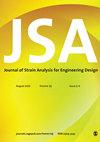表面和挠曲电效应对复合材料纳米棒静态弯曲响应的复合影响
IF 1.4
4区 工程技术
Q3 ENGINEERING, MECHANICAL
Journal of Strain Analysis for Engineering Design
Pub Date : 2022-05-09
DOI:10.1177/03093247221096518
引用次数: 2
摘要
纳米梁和纳米棒广泛应用于多种纳米机电系统及其应用,如传感器和执行器。表面电现象和挠性电现象对纳米结构有广泛的影响,并与它们的尺度依赖特性有关。本文利用线性压电理论、欧拉-伯努利(Euler-Bernoulli, EB)和伽辽金残差法研究了不同表面参数和挠性对石墨烯增强混杂复合材料(GRHC)纳米棒(nr)静电响应的影响。在此基础上,建立了GRHC NRs在点均布荷载(UDL)作用下的理论和有限元模型,研究了不同边界条件下GRHC NRs的静态弯曲挠度:悬臂(FC)、固定-固定(FF)和简支(SS)。本文提出的有限元模型为分析和调查分析模型的结果提供了一个有用的工具,这些分析模型的结果是一致的。我们的研究结果表明,表面电和挠性电对GRHC nr的静态弯曲响应的影响是值得注意的。这些影响随着NR厚度/直径的增加而减弱,因此,对于大尺寸结构,这些影响可以忽略不计。本文提出的结果将有助于确定GRHC nr在使用不同负载和边界条件以及石墨烯体积分数的NEMS范围内的静态弯曲响应方面的期望静电响应。目前的研究为开发具有增强控制权威的新型高效GRHC材料提供了途径,并且目前的模型可以用于许多其他材料以及线型结构系统,如梁、线、杆、柱/墩和桩,以研究它们的全局响应。本文章由计算机程序翻译,如有差异,请以英文原文为准。
Compound influence of surface and flexoelectric effects on static bending response of hybrid composite nanorod
Nanoscale beams and rods are extensively used in several nano-electro-mechanical systems (NEMS) and their applications such as sensors and actuators. The surface and flexoelectricity phenomena have an extensive effect on nanosized structures and are related to their scale-dependent characteristics. This article presents the effect of different surface parameters and flexoelectricity on the electrostatic response of graphene-reinforced hybrid composite (GRHC) nanorods (NRs) using the theory of linear piezoelectricity, Euler-Bernoulli (EB), and Galerkin residual method. Based on these theories, the theoretical and finite element (FE) model is produced to investigate the static bending deflection of GRHC NRs when subjected to point and uniformly distributed load (UDL) considering different boundary conditions: cantilever (FC), fixed-fixed (FF), and simply supported (SS). This proposed FE model provides a useful tool for analyzing and investigating the outcomes of analytical models, which are found to be in good agreement. Our results presented in this article reveal that the effect of surface and flexoelectricity on the static bending response of GRHC NRs is noteworthy. These effects diminish with increased thickness/diameter of NR, and hence, these effects can be neglected for large-sized structures. The results presented here would help to identify the desired electrostatic response of GRHC NRs in terms of static bending response for a range of NEMS using different loading and boundary conditions as well as graphene volume fraction. This current study offers pathways for developing new proficient novel GRHC materials with enhanced control authority and present models can be exploited for numerous other materials as well as line-type structural systems such as beams, wires, rods, column/piers, and piles to study their global response.
求助全文
通过发布文献求助,成功后即可免费获取论文全文。
去求助
来源期刊

Journal of Strain Analysis for Engineering Design
工程技术-材料科学:表征与测试
CiteScore
3.50
自引率
6.20%
发文量
25
审稿时长
>12 weeks
期刊介绍:
The Journal of Strain Analysis for Engineering Design provides a forum for work relating to the measurement and analysis of strain that is appropriate to engineering design and practice.
"Since launching in 1965, The Journal of Strain Analysis has been a collegiate effort, dedicated to providing exemplary service to our authors. We welcome contributions related to analytical, experimental, and numerical techniques for the analysis and/or measurement of stress and/or strain, or studies of relevant material properties and failure modes. Our international Editorial Board contains experts in all of these fields and is keen to encourage papers on novel techniques and innovative applications." Professor Eann Patterson - University of Liverpool, UK
This journal is a member of the Committee on Publication Ethics (COPE).
 求助内容:
求助内容: 应助结果提醒方式:
应助结果提醒方式:


